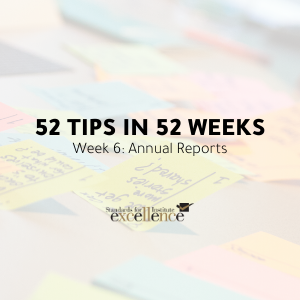This is part of a special series, brought to you by the Standards for Excellence Institute, to provide nonprofit leaders with a brief nonprofit governance and management tip weekly over the course of 2020. We hope these short tips will be helpful to you and the nonprofits you serve. If you have suggestions for future topics, please forward these to acmadsen@standardsforexcellence.org.
When I started with the Standards for Excellence in April 2019, one of my first tasks was to draft the 2018 Annual Report. After reading a few great annual reports for other organizations, I was overwhelmed – what should ours look like? What needs to be included?
Turns out, there are general guidelines organizations should follow. The Standards for Excellence: An Ethics and Accountability Code for the Nonprofit Sector advises that a nonprofit’s annual report should include five main elements:
- Your mission statement –This should be your organization’s current board approved mission statement.
- Program activities – This can mean many things – new and continuing programs, grants or awards received, or events your organization has put on. This is a way for you to show your organization’s impacts over the last year – share charts, graphs, tables and narrative.
- Financial Report – The information in this section is crucial to any annual report. It should include (a) a summary of an organization’s statement financial position or a balance sheet of assets and liabilities as well as (b) a breakdown of income and expenses. Many organizations (us included!) present the data in graphs or charts for it to be more easily understandable. If you do include charts and graphs, do be sure to include the totals rather than percentages only.
- Names of Board Members – After all, these are the people who are ultimately responsible for governing the organization.
- Names of Management Staff – In the same way the public should know who is responsible for guiding the organization, it should be clear who they can contact regarding participating in programs or activities.
The ultimate goal is to provide information to the public in a truthful and understandable way. So, in addition to these must-haves, you might elect to include a letter from leaders of your organization, donor recognition, discussion of partnerships, or your view of the future. You may also wish to augment the reports with quotes, case studies, and anecdotes from the past year. Whatever you choose to include, it should reflect truthfully on the work you do! Your annual report should be available to the public upon request and you should not charge a fee for it.
More information is available and helpful models and samples are available in the Standards for Excellence educational resource packet, Educating and Engaging the Public, which includes information on annual reports, as well as other methods for communicating with the public. Members of Maryland Nonprofits have access to this and all 27 Standards for Excellence Educational Resource Packets through the member portal.

